Adding regular and engaging content to your website is not only good SEO practice, it also helps reinforces your brand and shows your clients you’re engaged in subjects they care about.
I love writing copy. I get paid for what I love and have the opportunity to work on a completely different subject every day. When I’m writing for my clients, ideas on what to write about next come easily. When it comes to writing content for my own business, however, it’s often a job that’s forever on the longlist…
Do you too struggle to come up with content ideas? Or maybe the ideas are there but you never find the time to make a start? Here’s five pointers to help you create great written content for your business:
1.What are you going to write about?
Before you start to write, think about what you know about. Where do you and your company add value and how might you reinforce that through useful content (and definitely not as a sales pitch)?
What advice or thought leadership might you offer to customers to improve their understanding of a particular topic? How might that understanding then save them time, money, help them implement new processes or efficiencies, offer better customer service or win new business? What questions might they be seeking answers to?
A good starting point for coming up with your list of topics is answerthepublic.com which identifies search terms related to your topic posed via Google or Bing. A search on ‘photographer’, as an example, brings up search terms like ‘Can’t afford a photographer for my wedding’ and ‘How much do photographer prints cost?’ Understanding these customer ‘pain points’ will help you to address them through your content.
Twelve suggestions on content to get you started:
- Answer a typical customer objection such as ‘Why can’t I just do it myself?’ or question such as ‘How long should it take?’
- Give your opinion on new or proposed legislation
- What other changes are on the horizon that could affect your customers, and what do they need to be thinking about?
- Bust myths that might exist about your sector or business
- Celebrate a company milestone
- Describe a ‘day in the life of’ to explain what you and your team offer
- Launch a rebrand, new product or strategic partnership
- Interview a customer or celebrate their success
- Introduce a new member of staff
- Raise awareness of any voluntary work
- Share informative content published by others
- Re-visit a previous blog post that proved popular and look at ways to repurpose or continue that content
Once you’ve decided on your subjects, plan what you’re going to say before you start writing. Deviating from your key message is not only annoying for the reader, it can confuse Google’s algorithms and your page will be penalised as a result.
2. What format will work best?
Once you’ve decided upon your message, you’ll want to consider the best way of disseminating it to your audience:
- Blogs are a popular and easy way to get started and present a good opportunity to provide tips. Oreo PA gives some useful advice to busy business owners and managers in overcoming procrastination in That Project You’re Putting Off? Make 2020 the Year to Deliver!
- Useful resources and practical tools that can be implemented by a business time and again. LR Comms’ social media calendar 2020 offers food for thought on events in 2020 and how your business might celebrate and shout about them.
- Checklists are useful when the same points are applicable for a variety of situations like HubSpot’s 10-Step Checklist for Your Next Website Redesign or Yellow Bird’s 30-step events checklist.
- Whitepapers help readers to understand more complex issues or give solutions to problems. There’s a lot more work involved in researching your topic but the payback comes if you ask visitors to register their email to download. It’s a good opportunity to start building your mailing list (as long as you’re clear on what they’re signing up to).
- Case studies allow you to illustrate how you’ve addressed a particular business need. For apprenticeship provider Access Training their Employer case studies illustrate in very real terms how their recruitment and training services have accelerated growth and supported succession planning for their clients. For the D2 Business Starter Programme, their case study brochure demonstrates the impact of their training to other would-be start-ups in Derbyshire.
- Press releases when it’s something newsworthy and of interest to your audience.
- Social mediafor short and sweet postings for limited attention spans!
Need some help on how long or short your content should be? The Buffer Marketing Library gives useful advice on ideal content length.
3. When’s the best time to write?
Like any creative process, tackling it when you’re tired, hungry or with other deadlines to meet will make the task even harder. To avoid your time being hijacked by day-to-day business matters, carve out time in the same way you would annual leave.
Writing as much as you can in one sitting is highly efficient. Once you’ve found your stride, keep going for as long as you can; it’s much easier than coming back in separate sittings. You’ll also find you’ve so much more to say about a subject than you first anticipated. Et voila! You’ve created not just one blog but a whole series which can fill your content schedule for the next few months.
4. Where can you write undisturbed?
Find a space with lots of natural light, a view of the outdoors and where you’re not surrounded by clutter (which, in itself will be distracting). Switch off your phone and email alerts and just start typing. The time for reviewing will come later. The hardest line will be the first one!
5. Take the plunge!
Once you’ve committed your words to screen, leave the project for a good day or so. You want to come back to it with a completely fresh pair of eyes. Of course you’re looking for typos and any punctuation issues but you also want to check for readability. It often helps to read text out loud. If you find a particular sentence jarring, why is that? Is your choice of words not quite right? Or is it simply because a long sentence would be better split into two?
Get someone else to read it to ensure it can be understood and, importantly, it’s interesting!
Then, don’t wait for perfection! Hit ‘Publish’ and you’re well on your way…

